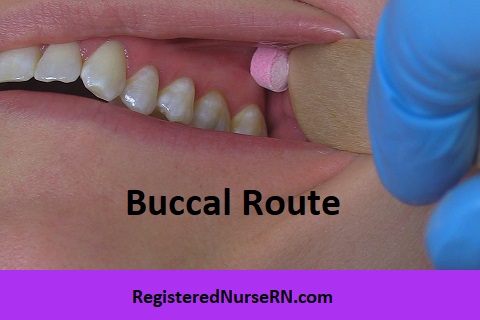The buccal route is a medication route that nurses can use to administer certain medications. Although this is not used as commonly as other medication routes, there are a few things to consider when giving a medication via the buccal route.
What is the Buccal Route?
What is the buccal route? The word buccal (pronounced “buckle”) comes from the Latin “bucca,” which means cheek. When administering a medication via this route, the medication is generally placed between the gums and cheek, which will allow it to be absorbed in the mucous membrane in the mouth and delivered into the bloodstream.
When a medication is placed between the gums and inner lips (instead of cheek), it is referred to as the sublabial route (labial refers to lips). The buccal route or sublabial route should not be confused with the sublingual route, which involves placing a medication under the tongue. However, some medications will allow for either sublingual or buccal administration, so always read the medication instructions for details.
Medications that Use the Buccal Route
The buccal route is not a very common method of medication administration, but some medication forms may allow or require this method. An example of some medication types that use the buccal route include the following:
- Certain Opioid / Pain Medications (example: some forms of Fentora / fentanyl)
- Smoking Cessation Medications
- Nitroglycerin
- Anti-seizure Medications
- Hormone Therapy Medications
- and more
Medications administered via the buccal route may come in a solid form (such as a quick dissolve tablet or lozenge), a liquid form (spray, syringe, or droplets), or as a buccal film that can be placed along the gums or cheek.
Buccal Administration Preparation
Before administering a medication via the buccal route, you’ll want to first perform your medication rights to ensure that you have the right patient, right medication, right dose, given at the right route, right time, and so forth.
Next, you’ll want to perform hand hygiene and don gloves.
You’ll want to quickly assess the patient’s mouth using a tongue blade. Make sure that there is not excess food or debris on the teeth or gums, and if there is, it may be a good time to perform mouth care for the patient.
Inspect the mucous membranes for any sores or lesions, and avoid placing the medication over those areas unless you are instructed to do so.
Read the Medication Instructions
Before administering the medication, it is important to read the medication’s instructions. Some medications will be very specific on the buccal placement. For example, the medication may instruct you to place the tablet above the 3rd maxillary molar or above an incisor tooth.
In addition, the medication instruction will dictate how soon the patient can eat, drink, or smoke once the medication has been placed, possible side effects, and so on. You’ll want to educate your patient about those details.
Furthermore, most medications will instruct the patient to avoid splitting, crushing, swallowing, or chewing the medication while it dissolves. However, some medications may allow swallowing once it has dissolved for a certain period. For example, one buccal form of fentanyl (Fentora) instructs the patient to allow the medication to dissolve for up to 25 minutes. However, after 3o minutes, the patient may swallow any remainder of the tablet with a glass of water.[1]
Therefore, be sure to read the instructions because medications differ on these important details.
If the patient has already received a prior dose of the medication, refer to the nursing documentation for your patient, as these medications sometimes require an alternate placement for additional doses.
How to Administer Medication: Buccal Route
Make sure your gloves remain dry before handling any tablets, as they are made to dissolve when they contact moisture. Use the tongue blade to open the cheek when you are ready to administer the medication. Place the tablet (or film/liquid) in the area specified in the medication’s instructions. For the example below, I placed the tablet above the maxillary left 2nd molar.

Once you place the medication, release the tongue blade and allow the cheek to close against the medication to help it dissolve into the mucous membrane. You may want to use your finger to gently hold the medication in place for a moment as it starts to dissolve, unless instructed otherwise.
Some medications can dissolve quickly in the buccal route, while some are meant to stay in place for several hours.
Once you are finished, doff your gloves, perform hand hygiene, and document.
Tips for Nurse Documentation
When you document, you’ll want to note the specific placement of the medication. For example, you might note that you placed the medication at the maxillary arch above the left second molar. This is important because some medications will require an alternate placement for additional doses, and the other nurses will need to know the last placement before administering another dose.
Note: These are general tips for administering medication via the buccal route and not meant as medical advice. Always follow your facility’s protocols and the medication instructions when administering any medication.
References:
FDA.gov. Fentora Fentanyl Tablet. https://www.accessdata.fda.gov/spl/data/51702896-c8d3-4d22-b515-7dbf3eb37e9c/51702896-c8d3-4d22-b515-7dbf3eb37e9c.xml#LINK_73684418-f482-473c-aedd-383fbe37d9cc